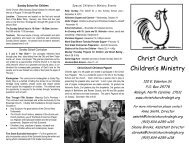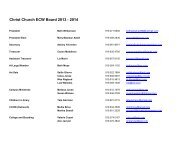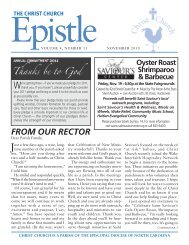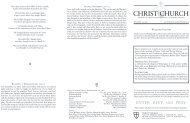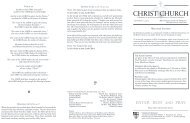The Mary Sumner Blount Legacy Guild - Christ Church
The Mary Sumner Blount Legacy Guild - Christ Church
The Mary Sumner Blount Legacy Guild - Christ Church
Create successful ePaper yourself
Turn your PDF publications into a flip-book with our unique Google optimized e-Paper software.
<strong>Mary</strong> (“Jackie”) <strong>Sumner</strong> <strong>Blount</strong><br />
1 7 7 7 - 1 8 2 2<br />
<strong>Mary</strong> <strong>Sumner</strong> <strong>Blount</strong> was the daughter and wife of Revolutionary<br />
War generals and the benefactor of <strong>Christ</strong> Episcopal<br />
<strong>Church</strong>, Raleigh, N.C. She was born in Warren<br />
County at the home of her father, General Jethro <strong>Sumner</strong> (1759-<br />
1812), founder of the N.C. Society of the Cincinnati. Having emigrated<br />
from England about 1690, the <strong>Sumner</strong>s settled near Suffolk,<br />
Nansemond County, Va.<br />
<strong>Mary</strong> <strong>Sumner</strong> became the second wife of General Thomas<br />
<strong>Blount</strong> of Edgecombe County, N.C., in November 1796. <strong>The</strong>y<br />
lived at a large plantation near Tarboro, N.C. <strong>Blount</strong> served as<br />
a lieutenant in the N.C. Continental Line, was taken prisoner of<br />
war, and later became a major general in the N.C. Militia. He<br />
was a trustee of <strong>The</strong> University of North Carolina, on the commission<br />
that laid out the city of Raleigh where one of the streets<br />
bears his name, and was a member of the U.S. Congress. He is<br />
buried in the Congressional Cemetery in Washington, D.C.<br />
<strong>Mary</strong> <strong>Sumner</strong> was left a large fortune at General <strong>Blount</strong>’s<br />
death. She died suddenly at the home of a friend in Tarboro. In<br />
her will she left money for the “building of a Protestant Episcopal<br />
<strong>Church</strong> in the City of Raleigh.” Duncan Cameron of Orange<br />
County and William Hooper of Fayetteville were named to carry<br />
out the intent of her will. <strong>The</strong> will stated that should any person<br />
contest the will, they were to be denied any inheritance due them.<br />
In 1826, the present church lot was purchased and a framed<br />
building erected.<br />
<strong>The</strong> Reverend John Philips, a missionary who is credited<br />
with starting the Episcopal churches in Washington and Warrenton,<br />
N.C., was the rector at Calvary <strong>Church</strong>, Tarboro, and a great<br />
friend to <strong>Mary</strong> <strong>Sumner</strong> <strong>Blount</strong>. It was Mr. Phillips who influenced<br />
Mrs. <strong>Blount</strong> to make a bequest to start a church in Raleigh.<br />
<strong>Mary</strong> <strong>Sumner</strong> <strong>Blount</strong> is buried in Calvary churchyard in Tarboro.<br />
It is believed that a bolt of lightning destroyed her tombstone.<br />
<strong>The</strong> present tombstone was a gift of the congregation of <strong>Christ</strong><br />
<strong>Church</strong>, Raleigh.<br />
<strong>Mary</strong> <strong>Sumner</strong> <strong>Blount</strong>’s portrait was painted in Washington,<br />
D.C. by the Italian artist Pietro Bonanni in 1820. It was a bequest<br />
to her dear friend Moses Mordecai and now hangs in Raleigh’s<br />
Mordecai House.




